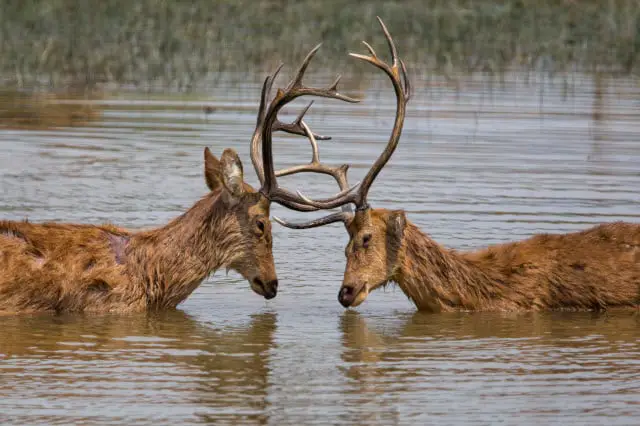Males of the Barasingha are well known for the elaborate ritualised contests that they have during the rutting season. These contests follow a standard set sequence from beginning to end.
Male Barasinghadeer have large complex antlers, which normally have 12 separate tines, but can have as many as 20. The antlers along with the male Barasingha’s relatively large size give them a distinctly impressive and majestic appearance.
When Does Barasingha Rutting Occur?
Table of Contents
ToggleThe rut occurs in the late autumn months, from September onwards. At this time of year the females congregate together and the males try to collect small groups of them into harems so that they can mate with them.
Unique Habits Before the Rut
During the rut the males adorn their antlers with grass and other pieces of vegetation to try to enhance their size and impressiveness. They also wade in mud wallows to help spread their scent around their body.
The Rutting of the Barasingha Swamp Deer
The most dominant males obtain possession of the harems, and do most of the mating. Dominance is established between the males using the highly ritualised mock fights.
Before engaging in a contest male’s size each other up by walking with a stiff gait, and giving out loud rutting calls. The rutting calls of the Barasingha are unusual in that they are made up of 2 syllables.
If the animals decide they are fairly evenly matched then the contest will continue to the ‘fighting’ stage. At the beginning of the ‘fighting’, the males face each other from some distance. They open their pre-orbital glands just below their eyes so that they emit powerful smelling scent. The two males will then lower there heads to the ground, while continuing to look at their opponent. Both males will then stamp and scrape their hooves against the ground. The contests rarely continue much further than this, as usually one of the male gives up and retreats.
However, if neither of the stags retreats, then the contest progresses. The males will then run at each other and lock there horns together. Then, the real fight begins. It is a trial of strength, with the weakest male losing and being forced back.
Although having such a long and drawn out contest might seem unnecessary, it actually reduces the risk of injury to the males. If a male is obviously weaker than his opponent he can retreat. Waving the white flag in this manner prevents a lot of injuries. Real fighting can be dangerous for both animals, and is only used as a last resort.



